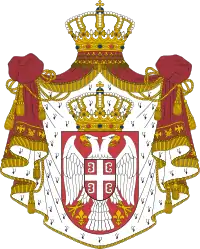Mother Serbia
Mother Serbia (Serbian: Мајка Србија / Majka Srbija, Србија мати / Srbija mati; German: Mutter Serbien), Serb Mother (Serbian: Српска мајка / Srpska majka) or Mother of All Serbs[1] (Serbian: Мајка свих Срба / Majka svih Srba), is a national personification of Serbia, which is the nation-state of Serbs. It was used as the metaphoric mother of all Serbs.[1] Serbian national myths and poems constantly invoke Mother Serbia.[2]

The territories inhabited by ethnic Serbs outside Serbia can be represented as the children of Mother Serbia.[3] Serbia may also be described as a daughter of Mother Serbia, alongside other Serb territories, as in Dragoslav Knežević's poem Mother Serbia: "One sister younger than the older Montenegro and Serbia, In peacetime and in war Krajina joins the Serbian flock".[3]
History

19th century
Dositej Obradović (1739–1811) extensively used Mother Serbia in his works.[4] The concept and term was used in many patriotic songs, such as Vostani Serbije, Oj Srbijo, mila mati, Oj Srbijo mati, etc.
On February 24, 1874, the "Serbian Liberation Committee for the Sanjak of Niš", known simply as the Niš Committee, was founded by local notables. Orthodox priest Petar Ikonomović swore Oath on the Christian cross and Gospel, reminiscent of the Orašac Assembly (1804).[5] Ikonomović said:
So together, brothers, and the Almighty shall help us all in his mercy, and soon permit us to weave the triumphal flag of our only faithful IV Obrenović on the Niš fortification. Hooray! Hooray! Hooray! Long live our beloved knightly Prince Milan M. Obrenović IV. Long live Mother Serbia!
— Petar Ikonomović, priest of Niš (February 24, 1874)[6]
Inter-war period
She [Serbia] sacrificed hundreds of thousands of her best sons, gave up her name, flag, existence, and eventually the blood of her king. But still they aren't satisfied and want more, they want to kill her spirit, rip out her heart, wipe out every trace of her, but this will never be! Mother Serbia will give more sacrifices, take more blows for the good of the King and our fatherland Yugoslavia, but she will endure.
— President of the Serbian women organisation "Dobrotvorna Zadruga Srpkinja" in Sarajevo, during the inter-war period.[7]
In 1940, Pavle Tatić wrote the drama Srpska majka.[8]
World War II

The propaganda of the Serbian puppet Government of National Salvation included promoting Milan Nedić as "Mother of the Serbs", claiming that he cared and shielded the Serbs.[9]
Yugoslav Wars
The expression was used during the Yugoslav Wars, referring to Mother Serbia's children in the west (outside Serbia and Montenegro) as the Republic of Serbian Krajina and Republika Srpska.
Milan Martić, President of the Republic of Serbian Krajina (RSK), argued, after the fall of RSK (Operation Storm), that "the people felt they had been deceived and abandoned by mother Serbia" for not protecting RSK.[10]
Use in art

- Statues and sculptures
- A statue at the top of the building of the Government of Serbia, of Mother Serbia holding a shield with the Serbian cross.
- Milić od Mačve's only sculpture, "Mother Greece and Mother Serbia" (Мајка Грчка и Мајка Србија), was erected in Kruševac in 1999, as a symbol of Greece's support of Serbia during the NATO bombing of Yugoslavia.[11][12]
- Đorđe Jovanović, "Velika Srbija" (Great Serbia, 1924)
- Songs
- "Oj Srbijo mati" (Oh Serbia Our Mother)
- "Oj Srbijo, mila mati" (Oh Serbia, Dear Mother)
See also
References
- Dubravka Žarkov; Kristen Ghodsee (13 August 2007). The Body of War: Media, Ethnicity, and Gender in the Break-up of Yugoslavia. Duke University Press. pp. 51–. ISBN 978-0-8223-9018-3.
- Renata Salecl (31 January 2002). The Spoils of Freedom: Psychoanalysis, Feminism and Ideology After the Fall of Socialism. Routledge. pp. 17–. ISBN 978-1-134-90612-3.
- Ivan Čolović (January 2002). The Politics of Symbol in Serbia: Essays in Political Anthropology. C. Hurst & Co. Publishers. pp. 32–33, 52. ISBN 978-1-85065-556-5.
- Petar Pijanović (2000). Život i delo Dositeja Obradovića: zbornik radova sa naučnog skupa Srpske akademije nauka i umetnosti održanog 15. i 16. decembra 1999. godine u Beogradu i 17. decembra 1999. godine u Sremskim Karlovcima. Zavod za udžbenike i nastavna sredstva.
- Danica Milić (1983). Istorija Niša: Od najstarijih vremena do oslobođenja od Turaka 1878. godine. Gradina. p. 298.
- Branibor Debeljković; Olivera Stefanović (2005). Old Serbian photography. Narodna biblioteka Srbije. p. 165.
- Nancy M. Wingfield; Maria Bucur (9 May 2006). Gender and War in Twentieth-Century Eastern Europe. Indiana University Press. pp. 165–. ISBN 0-253-11193-5.
- Pavle Tatić (1940). Srpska majka: drama u tri slike sa prologom. Štamparija"Natošević".
- Rebecca Haynes; Martyn Rady (30 November 2013). In the Shadow of Hitler: Personalities of the Right in Central and Eastern Europe. I.B.Tauris. pp. 302–. ISBN 978-1-78076-808-3.
- Thomas Ambrosio (2001). Irredentism: Ethnic Conflict and International Politics. Greenwood Publishing Group. pp. 88–. ISBN 978-0-275-97260-8.
- NIN. nedeljne informativne novine. Politika. 1999. p. 33.
- "Sele Majku Grcku i Majku Srbiju". Politika.
Further reading
- Bracewell, Wendy (1996). "Women, motherhood, and contemporary Serbian nationalism". Women's Studies International Forum. Pergamon. 19 (1–2): 25–33. doi:10.1016/0277-5395(95)00061-5.
External links
- http://www.politika.rs/rubrike/Sta-da-se-radi/Romanticna-majka-Srbija.lt.html. Missing or empty
|title=(help)
